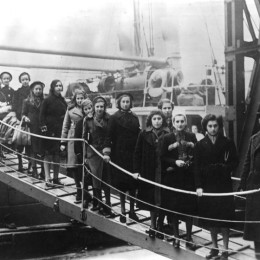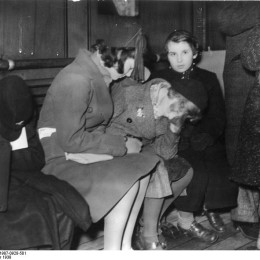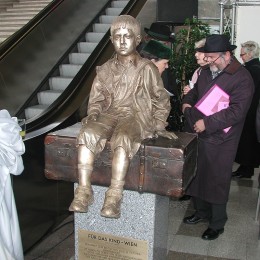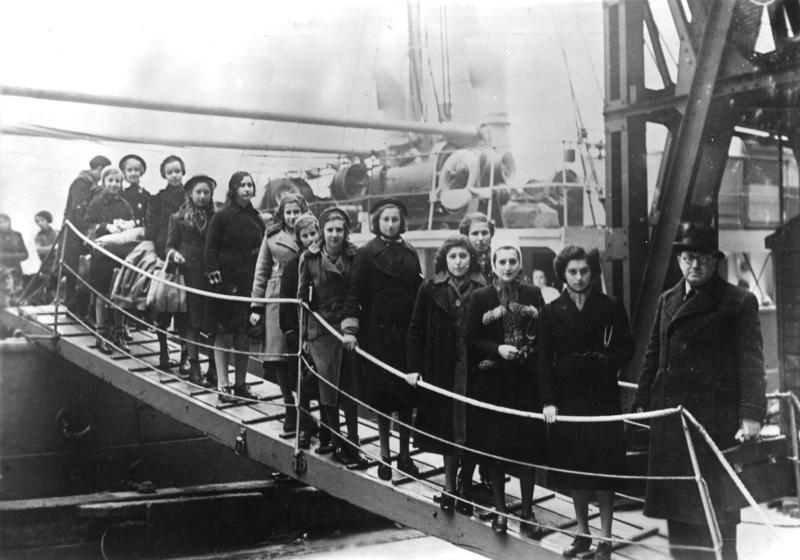Kindertransport (German for “children’s transport”) was an organised rescue effort that took place during the nine months prior to the outbreak of the Second World War.
On 15th November 1938, five days after the devastation of Kristallnacht, the Night of Broken Glass, in Germany and Austria, a delegation of British Jewish and Quaker leaders appealed in person to the Prime Minister of the United Kingdom, Neville Chamberlain. Among other measures, they requested that the British government permit the temporary admission of unaccompanied Jewish children, without their parents.
The British Cabinet debated the issue the next day and subsequently prepared a Bill to present to Parliament. That Bill stated that the Government would waive certain immigration requirements so as to allow the entry into Great Britain of unaccompanied children ranging from infants up to the age of 17, under conditions as outlined in the next paragraph. No limit upon, the permitted number of refugees was ever publicly announced. Initially, the Jewish refugee agencies considered 5,000 as a realistic target goal. However, after the British Colonial Office turned down the Jewish agencies’ separate request to allow the admission of 10,000 children to British-controlled Palestine, the Jewish agencies then increased their planned target number to 15,000 unaccompanied children to enter Great Britain in this way.


Within a very short time, the Movement for the Care of Children from Germany, later known as the Refugee Children’s Movement (RCM), sent representatives to Germany and Austria to establish the systems for choosing, organising, and transporting the children. World Jewish Relief (formerly the Central British Fund for Germany Jewry) were involved in the rescue operation.
On 25th November, British citizens heard an appeal for foster homes on the BBC Home Service radio station from Viscount Samuel. Soon there were 500 offers, and RCM volunteers started visiting possible foster homes and reporting on conditions. They did not insist that prospective homes for Jewish children should be Jewish homes. Nor did they probe too carefully into the motives and character of the families: it was sufficient for the houses to look clean and the families to seem respectable.
In Germany, a network of organisers was established, and these volunteers worked around the clock to make priority lists of those most in peril: teenagers who were in concentration camps or in danger of arrest, Polish children or teenagers threatened with deportation, children in Jewish orphanages, children whose parents were too impoverished to keep them, or children with a parent in a concentration camp. Once the children were identified or grouped by list, their guardians or parents had issued a travel date and departure details. They could only take a small sealed suitcase with no valuables and only ten marks or less in money. Some children had nothing but a manila tag with a number on the front and their name on the back, others were issued with a numbered identity card with a photo:
This document of identity is issued with the approval of His Majesty’s Government in the United Kingdom to young persons to be admitted to the United Kingdom for educational purposes under the care of the Inter-Aid Committee for children. / This document requires no visa. / Personal Particulars. / (Name; Sex; Date of Birth; Place; Full Names and Address of Parents)
The first party of nearly 200 children arrived in Harwich on 2nd December, three weeks after Kristallnacht. In the following nine months almost 10,000 unaccompanied, mainly Jewish, children travelled to England. There were also Kindertransports to other countries, such as France, Belgium and the Netherlands. Initially, the children came mainly from Germany and Austria (by then part of the Greater Reich). In March 1939, after the German army invaded Czechoslovakia, transports from Prague were hastily organised. In, February and August 1939 trains from Poland were arranged. Transports out of Nazi-occupied Europe continued until the declaration of war on 1 September 1939.

The very last transport from the continent, with 74 children, left on the passenger-freighter Bodegraven on 14th May 1940, from IJmuiden, Netherlands, organised by Geertruida Wijsmuller-Meijer, the Dutch organiser of the first transport from Vienna in December 1938. She could have joined the children, but chose to remain behind. This was a rescue action, as the occupation of the Netherlands was imminent, with the country capitulating the next day. This ship was the very last to freely leave the country.
As Holland was under attack by German forces totalling 750,000 men from May 10, and bombings had been going on, there was no opportunity to confer with the parents of the children. At the time of this evacuation, these parents knew nothing of the evacuation of their children: according to unnamed sources, some of the parents were initially even very upset about this action and told Wijsmuller-Meijer she should not have done this. After May 15, there was no more opportunity to leave Holland, as the country’s borders were closed by the Nazis.
